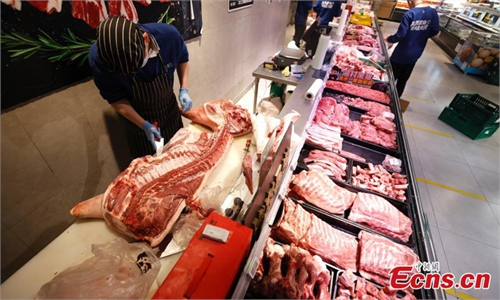
People select goods at a supermarket in Yuping Dong Autonomous County of Tongren City, southwest China's Guizhou Province, Jan. 1, 2023. (Photo by Hu Panxue/Xinhua)
China has effectively kept its consumer price index (CPI) at a low and steady range in contrast to the inflation seen in other major economies, the National Development and Reform Commission (NDRC) said on Thursday, expressing confidence that the nation can keep prices steady in 2023.
Through closely monitoring the prices of grain and energy, and improving the transport and distribution system for commodities, China was able to rein in the CPI at a time when runaway inflation was seen around the world, Wan Jinsong, an NDRC official, said at a press conference.
China kept the CPI below 3 percent every month in 2022, in sharp contrast to the US, which saw the CPI at 8 percent, and the eurozone, where the CPI surpassed 8 percent. China's CPI was also way lower than the UK's 9 percent, and the 7-10 percent figures seen in new emerging economies such as India, Brazil and South Africa, Wan said. The figures for these countries cover the January-November period.
China's 2022 CPI rose 2 percent year-on-year, a moderate growth rate, data from the National Bureau of Statistics showed on Thursday.
The NDRC said in 2022, the focus was put on monitoring and intervening when necessary in the prices of pork and coal, stabilizing market sentiment and reining in media outlets spreading groundless and inflammatory rumors.
China also worked to ramp up domestic energy production, natural gas in particular, to cope with high global energy prices, the agency said.
Li Changan, a professor from the University of International Business and Economics, told the Global Times on Thursday that China's CPI was in part subdued by weak domestic demand in 2022.
The development of domestic circulation as the mainstay and the application of new technologies have also played a part in reducing inflationary pressures in China, Li said.
In the first 11 months of 2022, China's sub-CPI reading for water, electricity and fuel was up only about 3 percent year-on-year, while the reading was 27 percent in the US and 38 percent in the eurozone. China also saw markedly smaller rises in gasoline and diesel prices.
For the whole year, the food index rose by 2.8 percent, which was way lower than the figures of about 10 percent in the US and Europe, the NDRC said.
The retail prices for rice decreased by 1 percent year-on-year in 36 medium- and large-sized cities while that of flour rose by 3 percent.
The agency said it has made arrangements to secure supply and stable prices for the upcoming Spring Festival holidays and recent monitoring shows that supplies and prices of staple goods were adequate and stable.
The World Economic Forum published a report on Wednesday, highlighting the cost of living as the No.1 near term-risk in 2023.
The NDRC said despite the likelihood that global commodity prices will remain high, combined with the persistent pressure of imported inflation, China has a solid foundation to keep prices steady in 2023.
Li said domestic demand should rise this year following the nation's optimized epidemic response and this will push up the CPI.
Li expects the government to set its inflation target for 2023 at no higher than 3.5 percent.


